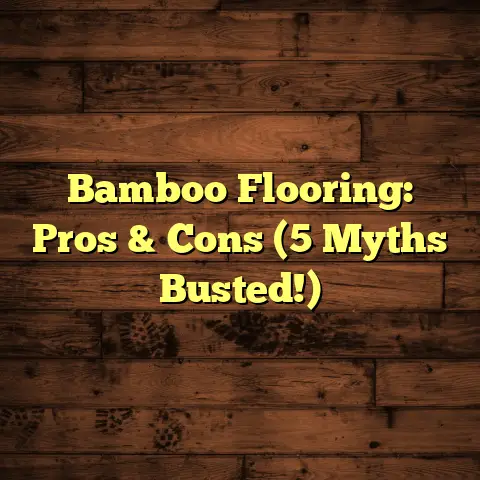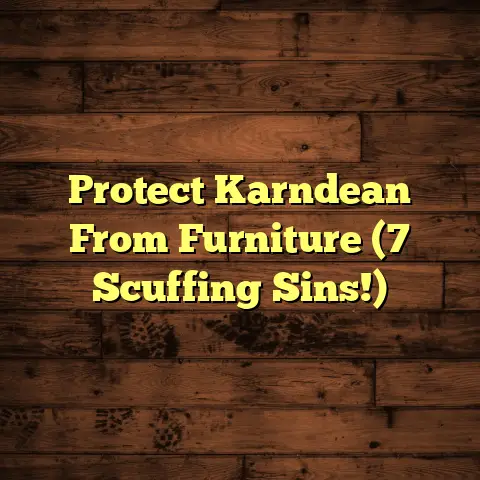Mold-Resistant Basement Floor Paint? (4 Best Buys!)
I’m a flooring contractor, and if there’s one thing I’ve seen countless times, it’s the havoc mold can wreak on a basement.
It’s damp, often dark, and sometimes neglected, making it the perfect breeding ground for mold.
But don’t worry, it’s not all doom and gloom!
The good news is that innovation in home improvement has come to our rescue with mold-resistant basement floor paint.
These aren’t your grandma’s paints; we’re talking advanced formulations designed to tackle moisture and keep those pesky mold spores at bay.
I’m here to walk you through why this stuff is a game-changer, and introduce you to some of the best options out there.
Trust me, investing in quality mold-resistant paint is a smart move, keeping your home safe, healthy, and looking great!
Section 1: Understanding Mold and Its Impact
So, what exactly is mold?
Well, it’s a type of fungus that thrives in damp environments.
It spreads through tiny spores that float in the air, and when they land on a surface with enough moisture, they start to grow.
Think of it like this: your basement is a potential buffet for mold if you’re not careful.
Common types of mold in basements include:
- Cladosporium: Often found on plants and decaying materials.
- Aspergillus: A common indoor mold that can cause allergic reactions.
- Penicillium: Known for its bluish-green color, often found in damp areas.
- Stachybotrys chartarum: The infamous “black mold,” which can produce toxins.
Basements are notorious for humidity, which is the perfect recipe for mold growth.
Cracks in the foundation, leaky pipes, and poor ventilation all contribute to this problem.
The health risks associated with mold exposure are no joke.
Breathing in mold spores can lead to respiratory issues, allergic reactions, and even more severe health problems, especially for those with asthma or compromised immune systems.
According to the EPA, mold can cause:
- Nasal stuffiness
- Throat irritation
- Coughing or wheezing
- Eye irritation
- Skin irritation
Here’s a sobering stat: The American Housing Survey found that about 24% of U.S. homes have evidence of mold.
That’s nearly one in four homes!
Preventive measures, like using mold-resistant paint, are crucial to protecting your health and your home.
Section 2: The Evolution of Basement Floor Paint
Let’s take a trip down memory lane and look at how basement floor paint has evolved.
Back in the day, basement floor paint was pretty basic.
It was mostly about adding color and maybe a little bit of protection against wear and tear.
But it didn’t do much to combat moisture or prevent mold.
Traditional floor paints often consisted of simple latex or oil-based formulas.
These paints were prone to peeling, cracking, and didn’t offer much in the way of water resistance.
The introduction of mold-resistant technology was a game-changer.
Modern mold-resistant paints are designed with specific features to tackle the unique challenges of basement environments.
These paints typically include:
- Water Repellency: Prevents moisture from seeping into the concrete.
- Durability: Resists chipping, scratching, and general wear and tear.
- Antimicrobial Additives: Compounds that inhibit mold spores and prevent their reproduction.
- Ease of Application: User-friendly formulas that are easy to apply, even for DIYers.
One of the most significant advancements is the inclusion of antimicrobial additives like zinc oxide or silver ions.
These additives create a hostile environment for mold spores, preventing them from taking root and growing.
Section 3: Key Features of Mold-Resistant Basement Floor Paint
Let’s dive deeper into what makes these paints so effective.
Moisture barriers are a critical component.
These barriers prevent water from penetrating the concrete, which is essential because mold needs moisture to thrive.
Look for paints that create a waterproof or water-resistant seal.
Additives are the secret weapon in the fight against mold.
These compounds, such as zinc oxide, silver ions, or other specialized chemicals, actively inhibit mold spores and prevent their reproduction.
They work by disrupting the mold’s growth process, effectively stopping it in its tracks.
While mold-resistant paint is a great defense, it’s not a silver bullet.
Proper ventilation is still crucial.
Good airflow helps to reduce humidity levels, making it harder for mold to grow in the first place.
Consider using a dehumidifier in your basement to keep moisture levels in check.
Now, let’s talk about aesthetics.
Mold-resistant paints come in a wide range of colors and finishes, so you don’t have to sacrifice style for functionality.
You can choose from:
- Epoxy Finishes: Highly durable and resistant to chemicals and stains.
- Acrylic Latex Finishes: Easy to apply and offer good color retention.
- Satin Finishes: Provide a subtle sheen that’s easy to clean.
- Matte Finishes: Offer a non-reflective look that can hide imperfections.
Section 4: The Top 4 Mold-Resistant Basement Floor Paints
Alright, let’s get to the good stuff!
I’ve spent years working with different paints, and I’ve narrowed it down to my top four mold-resistant basement floor paints.
Here’s my take on each, based on my professional experience.
1. Rust-Oleum EpoxyShield Garage Floor Coating
- Overview: Rust-Oleum EpoxyShield is a two-part epoxy coating designed for garage and basement floors. It’s known for its durability, resistance to chemicals, and, of course, its mold-resistant properties.
- Key Features and Benefits:
- High-gloss finish that’s easy to clean.
- Resistant to oil, gas, and other common chemicals.
- Self-priming, so you don’t need a separate primer.
- Excellent adhesion to concrete surfaces.
- Mold and mildew resistant formula.
- Application Process and User Experience:
- The application process involves mixing the two parts of the epoxy and applying it with a roller.
- It’s essential to follow the instructions carefully, as the epoxy has a limited working time once mixed.
- Users have reported that the finish is incredibly durable and long-lasting.
- However, some users have noted that the application can be a bit tricky, and it’s important to work quickly and evenly.
- Pricing and Where to Buy:
- Rust-Oleum EpoxyShield typically costs around $100-$150 per kit, depending on the size and retailer.
- You can find it at most major home improvement stores like Home Depot, Lowe’s, and Amazon.
2. Kilz Interior/Exterior Concrete and Masonry Waterproofing Paint
- Overview: Kilz Concrete and Masonry Waterproofing Paint is a latex-based paint designed to seal and protect concrete and masonry surfaces. It’s specifically formulated to resist water damage and mold growth.
- Key Features and Benefits:
- Waterproof formula that prevents moisture from penetrating concrete.
- Mold and mildew resistant finish.
- Can be used on interior and exterior surfaces.
- Easy to apply with a brush, roller, or sprayer.
- Available in a variety of colors.
- Application Process and User Experience:
- The application process is straightforward and similar to applying regular paint.
- It’s important to clean and prep the surface before painting.
- Users have praised its ease of application and its ability to effectively seal concrete.
- Some users have noted that it may require multiple coats for optimal waterproofing.
- Pricing and Where to Buy:
- Kilz Concrete and Masonry Waterproofing Paint typically costs around $30-$40 per gallon.
- You can find it at most major home improvement stores like Home Depot, Lowe’s, and Amazon.
3. UGL Drylok Concrete Floor Paint
- Overview: UGL Drylok Concrete Floor Paint is a latex-based paint designed to waterproof and protect concrete floors. It’s specifically formulated to resist water damage, mold growth, and efflorescence (the white, powdery substance that can appear on concrete).
- Key Features and Benefits:
- Waterproof formula that prevents moisture from penetrating concrete.
- Mold and mildew resistant finish.
- Resists efflorescence.
- Can be used on interior and exterior surfaces.
- Easy to apply with a brush, roller, or sprayer.
- Application Process and User Experience:
- The application process is similar to applying regular paint.
- It’s important to clean and prep the surface before painting.
- Users have praised its ability to effectively seal concrete and prevent water damage.
- Some users have noted that it may require multiple coats for optimal waterproofing and that it can have a strong odor during application.
- Pricing and Where to Buy:
- UGL Drylok Concrete Floor Paint typically costs around $35-$45 per gallon.
- You can find it at most major home improvement stores like Home Depot, Lowe’s, and Amazon.
4. INSL-X SU0921009-01 Sure Step Acrylic Anti-Slip Coating Paint
- Overview: INSL-X Sure Step Acrylic Anti-Slip Coating Paint is a unique product that not only provides mold resistance but also adds a non-slip texture to your basement floor. It’s a great option for areas where safety is a concern, such as around stairs or in laundry rooms.
- Key Features and Benefits:
- Mold and mildew resistant finish.
- Anti-slip texture for added safety.
- Durable acrylic formula.
- Easy to apply with a brush or roller.
- Available in a variety of colors.
- Application Process and User Experience:
- The application process is similar to applying regular paint, but it’s important to stir the paint thoroughly to ensure the anti-slip particles are evenly distributed.
- Users have praised its anti-slip properties and its ability to provide a safe and durable finish.
- Some users have noted that the texture can make it a bit more difficult to clean than smooth paint.
- Pricing and Where to Buy:
- INSL-X Sure Step Acrylic Anti-Slip Coating Paint typically costs around $40-$50 per gallon.
- You can find it at some major home improvement stores, as well as online retailers like Amazon.
Section 5: Real-Life Success Stories
Let me share a few stories from homeowners I’ve worked with who’ve had great success with mold-resistant basement floor paint.
Case Study 1: The Transformation of a Musty Basement
I worked with a family who had a basement that was always damp and musty.
They had tried everything to get rid of the mold, but nothing seemed to work.
I recommended they use Kilz Concrete and Masonry Waterproofing Paint, and the results were amazing.
The paint sealed the concrete, preventing moisture from seeping in, and the mold-resistant finish kept the mold at bay.
The family was thrilled with the transformation of their basement.
Case Study 2: A Safe and Healthy Playroom
Another homeowner I worked with wanted to create a safe and healthy playroom for their kids in the basement.
They were concerned about mold and wanted to make sure the floor was slip-resistant.
I recommended INSL-X Sure Step Acrylic Anti-Slip Coating Paint, and it was the perfect solution.
The paint provided mold resistance and the anti-slip texture made the floor safe for the kids to play on.
Testimonial: “No More Mold!”
“I was so tired of dealing with mold in my basement,” says Sarah, a homeowner from Ohio.
“I tried everything, but nothing seemed to work. Then I found Rust-Oleum EpoxyShield, and it was a game-changer. My basement is now mold-free, and it looks great!”
Conclusion
Using mold-resistant basement floor paint is a smart and proactive approach to home care.
It not only protects your home from the damaging effects of mold but also creates a healthier living environment for you and your family.
The innovative nature of these products makes them a valuable tool in modern home maintenance.
By investing in quality mold-resistant paint, you’re taking a significant step towards ensuring a safe, healthy, and beautiful basement.
Call to Action
I’d love to hear about your experiences with mold-resistant paints!
Have you used any of the products I mentioned?
What were your results?
Share your thoughts and questions in the comments section below.
And don’t forget to subscribe to my newsletter for more tips on home improvement and maintenance.
Let’s work together to create healthier and happier homes!





